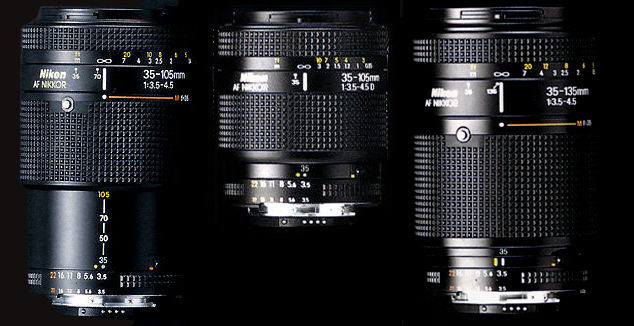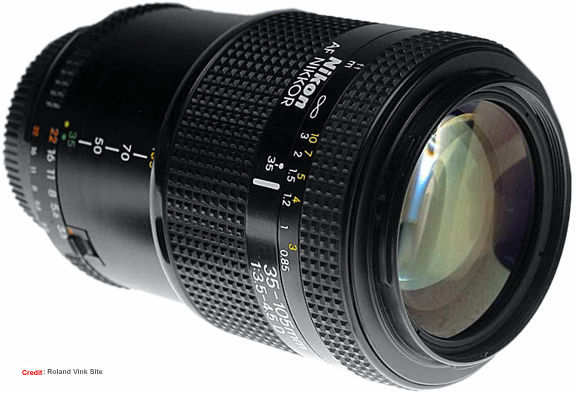Nikon AF Zoom-Nikkor
35-105mm
f/3.5~4.5D IF wide-telephoto
zoom lens
Introduced:
12.1994; Discontinued: 19.06.2001
The
best consideration among all the available options in the Nikon AF Zoom Nikkor 35-105mm
lens group was the AF-D version which other than fully compatible with current state
of Nikon film or digital SLR camera bodies, it also has an Internal Focus (IF) design.
The AF Zoom Nikkor 35-105mm f/3.5~4.5D IF was a radical change in its basic design
from any of the previous versions. It was re-introduced as a new zoom lens where
it has been completely redesigned from inside out rather than adopting an easy path
by updating the non-D version as an AF-D zoom lens.
 |
Interesting enough, Nikon has reverted back to a rotating zoom design for this AF-D 35-105mm zoom lens which is the basis for the original version introduced in 1986 and so, it is also different from the second revision which was offering a different one-touch zoom design too. Internally, it features a new 13 elements in 10 groups with an Aspherical lens element in its optical train where an Internal Focus design was adopted which provides the autofocus mechanism faster and more responsive. The use of aspherical lens element in its optical composition, other than provides a highly correction of various possible optical aberration to elevate its optical performance, it also enabling lesser number of lens elements to be used, the immediate benefit was a reduction of both the size and weight proportionally. The incorporation of the distance sensor in the lens section enables the lens has distance information relaying capability for any compatible Nikon camera models to enjoy the enhanced 3D Matrix metering with its related exposure and metering capabilities. For special effect lovers, the front filter of this version of the lens does not rotate while you focus (AF/MF), this has facilitated the use of special filters or accessories without the need for readjustment after the desired focus is achieved The use of aspherical in the optical group also has highly corrected the phase shift for infrared spectrum, so you may also notice the AF Zoom Nikkor 35-105mm f/3.5~4.5D IF only has a 35mm index for infrared compensation mark. |
. |
<<<--- A comparison among the three versions of the AF Zoom Nikkor 35-105mm f/3.5~4.5 lenses. Both shares many similarities in their exterior and cosmetic. The IF design enables the lens to remains constant - except in the case of zooming. The design which couples with the use of aspherical element has make it the most compact and lightweight among the three versions introduced thus far. NOTE: The comparing scales of the three lenses may not be entirely accurate as the D-spec lens is positioned at non-extension at 35mm zoom setting only (it will extend physically when zooming out. |
||
 |
The mosque next to a Buddhist temple.. |
The AF Zoom Nikkor 35-105mm f/3.5~4.5D IF has a typical modern AF Nikkor appearance. The manual focusing ring and zoom ring uses 4 and 9 rows of hard rubberized covered hand grip pattern. The rotating angle for manual focusing is surprisingly short, with just a 45° ~50° turn will lead you from its closest focusing setting of 0.85m all the way to infinity. Focusing action can be considered as smooth but lacks a positive feel as it is on a loose side - some may like it, some others may not. Unlike any of the predecessors, this AF-D 35-105mm Nikkor zoom lens doesn't provide any indication for a MACRO MODE as it delivers a maximum reproduction ratio of only a rather weak approx. 1/9.3 ratio even though the closest working distance is a short 3 feet. Thus, I guess the AF-D lens has been compromised with the lack of the close-focusing compensating mechanism and probably Nikon optical designers thought the lens was not supposed to complicate their main objective in making the lens more functional in other areas. For potential consumers of this popular AF-D Nikkor zoom lens, behind the lens data has a "D" letter after the marked 1:3.5-4.5D so as to differentiate this AF-D zoom lens from the non-D versions. If you are still not sure about what you are buying, just locate the infra index near the focusing index mark as this AF-D spec Nikkor zoom was the only version that has a sole 35mm index reference while all previous two versions had both 35mm and 105mm indexes marked near the distance scale (MK II)/ window (Original). The rear lens mount of this AF Zoom Nikkor 35-105mm f/3.5~4.5D IF zoom lens was still a metal piece which is a rare treat as during this period onwards, Nikon has began installing plastic lens mount in many of their autofocus lenses and so, a metal lens mount is always delightful to see such an old tradition being retained in a lens design.
 |
|
Purely using the lens spec sheet alone for evaluation, the AF Zoom Nikkor 35-105mm f/3.5~4.5D IF may position itself as the best option you can find within the AF Zoom Nikkor 35-105mm lens group but I doubt the lens has been sold very well in numbers as prices of wideangle zoom lenses had been self adjusting to maintain its competitive edge in the market - in particularly when there were a number of similar lens type offered by third party labels. Besides, consumers awareness has switched to a wider picture angle when selecting a wide tele zoom lens. Further, Nikon's AF Zoom Nikkor lens group did offered quite a number of other alternatives like AF Zoom-Nikkor 28-105mm f/3.5~4.5D, AF Zoom-Nikkor 24-120mm f/3.5~5.6D IF etc. which offer a better consideration of a wide-tele zoom lens. So, the competition does not necessary came from externally. Well simply based on logical thinking to choose a wide-telephoto zoom lens for own use, I would rather select a wider startup wider angle than the 35mm too. Currently, the price variation among the three AF Zoom Nikkor 35-105mm in the used equipment market can be quite wide. For those who may be narrowing their choices to this 35-105mm lens group - you may have your own reasons to do so but all I can offer you with an advice is to patiently hunt for a bargain and invest wisely online.
Anyway, for those who may be still shooting with both manual and autofocus Nikon SLR cameras, this AF-D Nikkor 35-105mm zoom lens should supplement your needs very well. For as long as your MF Nikon has an Ai-Spec you can use it freely with any exposure modes your MF Nikon can provide which includes Shutter Priority and normal or high speed Programmed AE modes as provided by Nikon FA, Nikon FG or Nikon F301. All you need to do is prior prepare to shoot, just set and lock the minimum aperture value via the minimum aperture lock. For other popular Nikon models such as the mechanical Nikon FM2N series, the hybrid Nikon FM3A or cameras that offer manual exposure control cum aperture priority AE such as Nikon F3, just use the lens as a normal Ai-S Nikkor zoom lens. For users of pre-3D Matrix Meter Nikon SLR camera models such as Nikon F4s, it will behave as a normal Ai-S autofocus Nikkor zoom lens and all your exposure and metering system will be retained and functioning normally. The best combination of this AF-D Nikkor zoom lens is to use it with a compatible (film or digital) based Nikon SLR camera bodies that offers 3D Matrix Metering (which includes 3D Color Matrix). It will unleash its full potential as an AF-D optic for both Matrix ambient and flash control. So, I would conclude the best element for this AF Zoom Nikkor 35-105mm f/3.5~4.5D IF is with its full system compatibility. Personally, I would easily rated this lens an above average performer for both lens handling as well in its optical performance. Except for the weaker factor found in the 35mm wideangle setting, the lens as a whole can be still considered as versatile enough for a wide scope of picture taking situations which includes outdoor portraiture, street photography, scenic, nature, fashion, candid as well as a great companion lens for traveling for other general photography. As many of the Nikon higher end speedlight models do provide good flash coverage extension for telephoto range of 105mm, this zoom lens can also be an excellent choice for indoor studio fashion or product photography with a TTL flash. Although many people may be still skeptical to consider it as a good investment for a moderate wide-telephoto zoom lens, but I guess the AF Zoom Nikkor 35-105mm f/3.5~4.5D IF does possessed a few good elements within to enhance your photography.
 |
A late work at a construction site near Kuala Lumpur city centre (KLCC). Gradual filters. |
![]()
Technical
Specification
for Nikon AF Zoom Nikkor 35-105mm
f/3.5~4.5D IF lens:-
Type of lense: Autofocus Nikkor zoom lens with variable aperture, built-in
CPU and a metal rear Nikon bayonet mount
Focal length: 35mm to 105mm; Maximum aperture: f/3.5; (35mm=1:3.5;
approx. 70mm=1:4.0; 105mm=1:4.5) Minimum Aperture: f/22; approx. 50-160mm
on DX format DSLR
Lens construction: 16
elements in 12 groups;
with close focus Design
Picture angle: 62°
- 23°
20'
Focal
length scale: 35mm (Light Green), 50mm, 70mm, and 105mm (Yellow)
Diaphragm: Fully automatic,
Focus
control: Via focusing ring
Zoom control: Via one-touch / sliding zoom ring
Distance scale: Graduated in meters and feet/inches from 1.4m to infinity
(OO); nearest focus distance @ 0.85m (3 feet)
Distance information: Output into camera body with CPU interface system IS POSSIBLE with this lens (for focus distance info); Option for manual focus provided |
Infrared compensation index: Provided for the 35mm focal length setting ONLY
Standard accessories: 52mm front lens cap; Rear lens cap LF-1; Hard lens case CL-32S (older models designed for earlier models may also be possible)
Optional Accessories: 52mm screw-in filters; Bayonet hood HB-5 *; Flexible lens pouch No.62. CP 9 may also be usable
Dimensions: Approx. 68.5mm dia. x 72.5mm
Weight: Approx. 415g
Compatible Tele-Converters: - TC-201S; TC-14A (Note: MANUAL focus only); 2X and 1 f-stop exposure compensation required, not advisable in such combination. Others: Polarizer II not possible. AF-3 / AF-4 possible.
Startup Serial Number for the Nikon AF Zoom Nikkor 35-105mm f/3.5~4.5S lens may have been began from: 4000001 < 4000177 - 4055204 > Dec94 - Jun01 Jun91 - Dec94 Reference: Roland Vink's lens data sheet.
| BACK | 3/3
Original
Version (1986~1991)
| Nikon
AF zoom Nikkor 35-105mm f/3.5~4.5s MK II (1992~1994) | Nikon AF zoom Nikkor 35-105mm f/3.5~4.5D
IF MK III (1995~2003/4); Relative: Manual Focus Nikkor Zoom 35-105mm f/3.5~4.5s
EXTERNAL LINKS:- information
on this lens on the Internet is scarce. Here are some:- A write-up of this brief
encounter of the Nikkor zxoom by Liang
Wu-Cia; Version History by Roland Vink
Main Index Page - Autofocus Nikkor lenses
| Message Board |
for your
Nikkor
Optics
in a shared environment
| Message Board | Specifically for Dispose or Looking for new/used Nikon/Nikkor photographic equipment
| Nippon Kogaku Rangefinder Resources | Nikon F | Nikon F2 | Nikon F3 | Nikon F4 | Nikon F5 | Nikon F6 | Nikkormat / Nikomat | Nikon FM Series | Nikon FE/ FA | Nikon EM/FG/FG20 | Nikon Digital SLRs | Nikon - Other models |
Nikon MF RF-Nikkor lenses for Rangefinder
cameras:-
Main Index Page
Nikon
Auto Focus Nikkor lenses:- Main Index
Page
Nikon
Manual
Focus
Nikkor lenses:-
Fisheye-Nikkor Lenses - Circular |
Full Frame |
Ultrawides Lenses - 13mm15mm18mm20mm |
Wideangle Lenses - 24mm28mm35mm |
Standard Lenses - 45mm 50mm 58mm | Telephoto Lenses
- 85mm105mm135mm180mm & 200mm |
Super-Telephoto Lenses - 300mm 400mm 500mm 600mm 800mm 1200mm |
 |
Special Application
lenses: Micro-Nikkor Lenses - 50mm~55mm -60mm 85mm -105mm 200mm Micro-Zoom 70-180mm Perspective Control (PC) - 28mm 35mm PC-Micro 85mm Dedicated Lenses for Nikon F3AF: AF 80mm f/2.8 | AF 200mm f/3.5 EDIF Depth of Field Control (DC): 105mm 135mm Medical Nikkor: 120mm 200mm Reflex-Nikkor Lenses - 500mm 1000mm 2000mm Others: Noct Nikkor | OP-Nikkor | UV Nikkor 55mm 105mm | Focusing Units | Bellows-Nikkor 105mm 135mm Nikon Series E Lenses: 28mm35mm50mm100mm135mm | E-Series Zoom lenses: 36~72mm75~150mm70~210mm |
MF Zoom-Nikkor Lenses: 25~50mm | 28~45mm | 28~50mm | 28~85mm | 35~70mm | 36~72mm E | 35~85mm | 35~105mm | 35~135mm | 35~200mm | 43~86mm | 50~135mm | 50~300mm | 70~210mm E | 75~150mm E | 80~200mm | 85~250mm | 100~300mm | 180~600mm | 200~400mm | 200~600mm | 360~1200mm | 1200~1700mm
Tele-Converters: TC-1 | TC-2 | TC-200 | TC-201 | TC-300 | TC-301 | TC-14 | TC-14A | TC-14B | TC-14C | TC-14E | TC-16 | TC-16A | TC-20E
Recommended links to understand more technical details
related to the Nikkor F-mount and production Serial Number:
http://rick_oleson.tripod.com/index-153.html by: my
friend, Rick Oleson
http://www.zi.ku.dk/personal/lhhansen/photo/fmount.htm by: Hansen,
Lars Holst
http://www.mir.com.my/rb/photography/hardwares/nikonfmount/lens2.htm
http://www.photosynthesis.co.nz/nikon/serialno.html
Recommended Reading Reference on Nikon cameras and Nikkor lenses | about this photographic web site
| | Back | Main Index Page of Nikkor Resources | Back | Main Index Page of Pictorial History of Nikon SLRs |
| Home - Photography in Malaysia |
![]()
Credit: To all the good
people who has contributed their own experience, resources or those who are kind
enough granting us permission to use their images appeared in this site Note:certain
content and images appeared in this site were either scanned from official marketing
leaflets, brochures, sales manuals or publications published by Nikon over the years
and/or contribution from surfers who claimed originality of their work for educational
purposes. The creator of the site will not be responsible for may discrepancies arise
from such dispute except rectifying them after verification."Nikon", "Nikkormat", "Nippon Kokagu
KK"
& "Nikkor" are registered
tradename of Nikon Corporation Inc., Japan. Site made with an Apple IMac.